'Why Verify the DVD' Continued...Page 2 Return to Page 1
Most Authoring Houses cannot Verify
Put aside for a moment that most authoring studios do not use the EclipseSuite (of which Eclipse ImageAnalysis is the major component the replicator uses to check the DDP Image). The lack of these and other tools in the vast majority of DVD production house's arsenal, alone, show that the authoring studio is not capable of assuring the Image is error free, and minimally risk the Image will not be in sync with the replicators mastering process.
We'll concern ourselves in this section with what is currently 'accepted' industry practice for formatting and 'proofing' the DLT for replication.
Typical authoring house replication submission procedure:
The project is formatted into a DVD+-R, and playback checked in several machines and on a couple of computer drives. If all performs well it is sent for client approval. With that OK, the build folder, whose contents form the basis of the image that created the DVD-R, is formatted by the authoring system or other formatting tool, to DLT tape. Then, two admirable attempts are made to check the Image's DLT formatting:
1) Verify-after-write (or 'Compare') is inadequate, because crucial components the replicator needs to master the Image; the now DDP Image on the tape, which include a new configuration of the data and several important files (DDPID, CONTROL.DAT, MAIN or IMAGE.DAT, ISO / UDF bridge) have only been written to DLT and do not also exist on the hard drive to be compared against during the Verify-after-write operation.
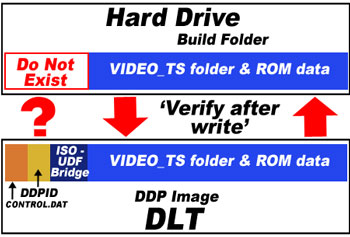
If Verify-after-write is used on a CSS copy protected image, the build folder's contents (still on the hard drive) being compared, not only doesn't have the DDP file set and ISO UDF bridge mentioned above to compare, but lacks the same sector sizes as the Image just formatted to the tape (2054 bytes per sector as opposed to 2048), which makes a true compare problematic.
The only way to 'Verify-after-write' correctly, would be to format the DDP file set containing the Image to hard drive first, then transfer the files to DLT, and then do a Verify-after-write operation. Unfortunately, even though most authoring systems will format all the DDP file set components to hard drive, none of them will transfer the DDP file set it just wrote to the hard drive, onto the DLT, which is the only way a Verify-after-write operation could be meaningful.
Note: Even DVDAfterEdit Mastering Edition doesn't transfer a DDP file set on hard drive to DLT (If I'd known the importance of this back then, it would have been included! I always had Eclipse ImageAnalysis with me, so I was always able to check it's Images. Sorry about that).
2) Restore the DLT Image for Playback Testing: Scenarist, Creator, DVD Studio Pro, Maestro, DVDAfterEdit ME, Gear Pro Mastering Edition, and other DLT formatters can only restore a disc image from the DLT, leaving out the same crucial components of the DDP file set that do not also reside on the hard drive and are not extracted off the tapes.
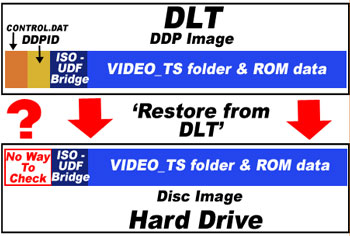
If these authoring systems are copy protecting the Image with Macrovision and/or CSS, the Image cannot be restored to hard drive for playback testing at all, due to the Image on the tape now having different sector sizes for DVD Images (2054 bytes per sector instead of the original 2048). The replicator hasn't completed the DVD Image for these project types yet, which is done by inserting the encryption keys and manufacturing a DVD-Video DVD-ROM.
Note: DVDAfterEdit ME is the only application that reconstitutes the CSS flagged DDP Image on DLT back to 2048 bytes per sector for restoring onto the hard drive for playback testing and/or further editing..but know this featue isn't foolproof, and in fact, does not always work.
Restoring the DLT's contents to play back the Image on the hard drive is good for testing certain parameters of the Image; like that certain project elements got on the DLT, or just as importantly, that elements from past projects didn't get on the Image, which is unfortunately not uncommon with DVD Studio Pro projects! So this practice is recommended. Just know, that ALL the files the replicator needs to master the DVD are not accounted for (CONTROL.DAT, DDPID, MAIN.DAT), and that they're accurately constructed with no errors.
The authoring studio will have to wait until the Image gets past the replicator's Eclipse ImageAnalysis and the Lead-in is mastered onto the check disc before knowing if the DDP file set and Image it describes, was generated correctly by the authoring system.
The Unanalyzed and Unverified DLT Heads to the Plant
So the Image on DLT barrels to the plant with the authoring studio 'knowing or should know' that DVD authoring systems and formatters regularly output DDP files sets and Images with errors which cannot be uncovered by 'Verify after write' or 'Restore from DLT'.
Some of the most stoic amongst us start getting a little 'superstitious' about now.
The authoring system and format software support sites regularly contain scenes describing problems at the plant after the Verify-after-write (also known as 'Compare') and Restore from DLT were performed. Here's an example from a support site with an author with a "seamless playback flag set incorrectly at the layer break" Eclipse ImageAnalysis warning at the replicator's (which often means the layer break did not occur on a cell at all). This author ' Compared' his DLT's with the build folder, which 'passed', before sending them in to the plant:
"SO, it's an absolutely time-critical rush job, (of course!) with 60,000 to be pressed (of course!) and I'm not sure what to do. On the one hand I trust DVDAE implicitly, on the other hand it's quite a risk if the DLTs were written incorrectly, and the evidence seems to suggest that there may be a problem with the DLTs..." Link to the full thread
Here's a web site blog of an Indie Filmmaker, describing over a month of rejections at the plant (7 total rejections) of a DVD Image he submitted with DVD Studio Pro 4.1. This DVD-9 size DDP image had some of the most bizarre Image Analysis results ever seen by me and even the Eclipse tech support team. In another article on the upcoming DVD Producers' Guild web site, we will be going over the details of this amazing DDP file set (incorrectly constructed on DLT, hard drive, and DVD-R, so there was no escape from it with this project no matter what was tried). DDP errors galore were wrapped around an otherwise fixable DVD Image.
TFDVD Research Labs was honored to have been involved with this one:
Huge thanks to Trai Forrester, the professional troubleshooter who rescued us from DVD hell. If you're ever thinking about making your own DVD, I definitely recommend checking out his site. Todd Peterson - One Tiny Whale
Again, for the reasons diagrammed above; these useful proofing routines are not enough to qualify an image as ready for replication, because they don't account for checking the control data and DDP file set; that it got on the DLT tape, and that all the data in them are free of errors.
By contrast, 'Hollywood' level authoring studios run ALL the components of the Image through mandatory tests. MEI, Interra Surveyor (no longer sold), Eclipse ImageAnalysis, and other analyzers and verifiers are standard testing before Images are submitted to replicators by these enterprises. Authoring studios who work for these company's are instructed, in writing, that these tests must be run on the various file systems and the results submitted to the producer.
TFDVD Research Labs pre-mastering workflow on the two packages we offer here are even more stringent, as we will mount the Image just embedded in the final DDP file set (joining the two "MAIN.DAT" files in the Layer 0 and Layer 1 folders for a dual layer Image), and run a file compare with the original VIDEO_TS folder that was previously fully tested by us in our Premiere Proofing / Pre-mastering Package, or by the authoring studio in our Standard Pre-mastering Package, before being formatted into the DDP Image.

Joining the two MAIN or IMAGE.DAT segments in the two layer folders for a DVD-9 size DDP Image is quickly accomplished in the Mac OS Terminal. Changing the suffix of the resulting joined file from ".DAT' to '.IMG' will let the Mac OS mount it.
The only thing that should change in the VIDEO_TS folder now in the DDP Image, from the VIDEO_TS folder on the hard drive, are the VIDEO_TS.IFO AND VIDEO_TS.BUP files; as the VTS start sector locations found in tables there are adjusted by the formatting to account for the new VTS start sector locations, when the ISO/UDF bridge is tacked on to the front of the VIDEO_TS folder, which is what makes it an Image (sorry about that long sentence!). These new VTS start sector numbers are also checked by loading in the embedded VIDEO_TS folder into a spec compliant utilities we have here.
After that, TFDVD Research Labs employs Eclipse ImageCopy ($13,000) to transfer, analyze (including checking the 'invisible' UDF file set for spec compliance, that the CONTROL.DAT has the proper matching relevant values found in the DDPID and Image, etc., as Eclipse ImageAnalysis is integral to ImageCopy), and then ImageCopy does a Verify-after-write pass. The DLT itself is checked for 'soft errors' during the transfer, to insure that the Image landed on a good tape which can be read back by the replicator.
DVD-Recordable Media are not suitable Replication Masters
 DVD recordables are used increasingly to submit Images to the plant, even by authoring studios who should know better, and are being accepted by replicators who also should know better. Of course, cost and convenience is the main factor, and replicators have succumbed to competitive market conditions in accepting masters on recordable media. DVD recordables are used increasingly to submit Images to the plant, even by authoring studios who should know better, and are being accepted by replicators who also should know better. Of course, cost and convenience is the main factor, and replicators have succumbed to competitive market conditions in accepting masters on recordable media.
Most authoring houses have heard " DLT is the way to go", but It doesn't help that DLT drives and tapes are much more expensive. The fact that most studios can't see the files on the DLT tape may contribute (unreadable DLT tapes are sometimes an issue at the plant when un-pre-analyzed DLT's are submitted). However, DLT plays a crucial role for any authoring studio wanting to preserve the verified Image as it leaves their control. And DLT tape is the best way to help the replication facility treat the Image as the authoring studio intends. Only hard drive or large capacity USB memory sticks (and FTP transmission) are otherwise acceptable for professional Image submission, but only a few replicators accept these formats.
READ ERRORS
The usual arguments against using DVD-R for replication masters all apply; too fragile, easy to get thumbprints on them, etc., but the main reason is even a perfectly recorded and immaculate DVD-R has an unacceptable chance to run into trouble at the plant - due to a replicator's drive possibly not being able to read all the data on the platter.
NIST DVD-R Compatibility Study shows DVD Recordable discs are, at best, suspect Master carriers
Tests conducted by the National Institute of Standards and Technology, as reported in March 2005, by NIST Technical Staff Member Oliver Slattery, were geared towards DVD recordable compatibility for consumers. For our purposes here, since we're taking into account all factors in an overall bullet-proof DVD Quality Assurance and DVD verification strategy, these results show there are too many variables to allow Recordables into the equation.
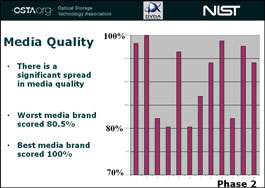 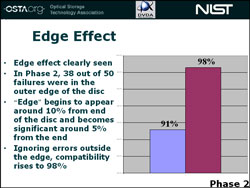
As their study shows, media quality varies too wildly, as most authoring studios know already from burning and in-house playability testing over the years. Not accounted for in this study is the variance of media quality within different batches of the same brand, which is also a known occurrence.
The 'Edge effect' has been a known gotcha for DVD-Recordables since at least 2001. and effectively limits DVD recordable to slightly more than 10% less than its stated capacity. Richard Mizer, acting officially with the DVD Working Group of SMPTE (Society of Motion Picture and Television Engineers), approached DVD professionals on the Tully DVD List for help in identifying this very issue, almost 5 years ago :
"At today's meeting the topic came up about the inability of DVD players to play the last bit of data on a 4.7 DVD-R. In other words, if you put more than 4.5 Gs on it the last bit of video will start to break up etc....I have personally observed this on a project I helped on, and while the results were inconclusive, there is definitely a problem. What SMPTE would like to know is... " (The whole interesting thread starts here)
So, if a lowly DVD player running at 1X has problems at the outer edge of the DVD-R, what's going to happen when a replicator's high speed DVD-ROM drive try's to pull the data off? That probably depends on the media quality and the next important unacceptable variable:
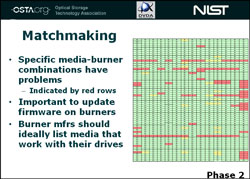 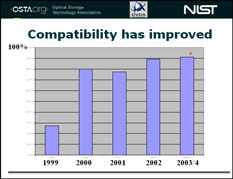
The NIST tests confirm what most DVD professionals know; there's a problem out there with DVD-R's being burned in one writer, being reliably read by other optical drives. The NIST recommends manufacturers of drives list the brands of media they work with ...doesn't sound too good for our verification/QC purposes, which require bullet-proof replication submissions.
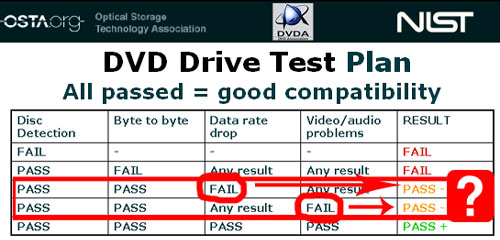
Although compatibility/readability for DVD-R has improved over the years, it still doesn't approach the 100% reliability required for the DVD mastering process. Also, the NIST included marginal performance, as shown above, in their 'passed' criteria. Failed 'Data rate drops' and 'Video / audio problems' translate into failed transfer of the data that needs to be included on the authoring studio's master stamper.
Replicators regularly cite figures as high as 20 percent outright rejection of Images submitted on recordables. This replication broker, reports an even higher failure rate:
"This happens about 30% of the time with DVD-R's. Because of the high failure rate of DVD-R, we recommend a more stable format of master called DLT or Digital Linear Tape."

Eclipse ImageAnalysis report shows unreadable sectors on this DVD-R
The figures for how many DVD's are manufactured with errors due to DVD-R master submission, are not available. But it is possible for 'errors' to get on the glass master at the plant from a dropped sector reading from an Image on DVD-R. The way it works is the software the replicator uses to control their Laser Beam Recorder which is etching on the glass master, can be instructed to insert zeros when a drop of data from the source occurs, whether the data actually doesn't exist, or there's a read error . The replicator has full control on what conditions this is permissible, i.e., how often, and the maximum number of contiguous zeros to write (how big of an error they will tolerate 'covering up').
I do not believe (belief is not knowledge, I'm well aware) most replicators have this feature 'turned on', and would hope that the replicator would just outright reject an image instead of go this route, when imperfect masters are encountered.
The rationale behind allowing this is barely supported by the fact that the DVD Format has robust error correction through the decoding process, that can recover playback from small gaps in the data (this doesn't work if the error occurs in the IFO files, which are responsible for the discs navigation!).
But to insure that the ECC (Error Correction Code) of the DVD format has the best chance of playing the replicated disc perfectly out there, the authoring studio needs to make sure they present a faultless Image in the best possible way for the plant to read the data, which is on you-know-what (DLT).
Though we prefer hard drive or FTP, here at TFDVD Research Labs, we treat DDP Images or 'playable' Disc Images submitted to us on DVD-R, as an FTP transmission; We require MD5 checksums be included with the files submitted on DVD-R by the authoring studio, so we can verify that our 'reference' drives (as approved by Eclipse Data Technologies) have properly transferred all the data off the platter, and that the authoring studio's burn was accurate in the studio; so we can do our checks before formatting to DLT.
A couple of other Gotcha's await DVD-R 'Masters' at the plant:
Submitting 'Playable' DVD-R's: At more than a few replication facilities, using a DVD-R that plays the show in DVD players and computer drives as the replication master, can result in the manufactured discs identifying themselves to players as DVD recordable's, rather than a DVD-Video DVD ROM (manufactured disc).
Here's a quote from a replicator's web site discussing the issue:
"We can also use a DVD-R for mastering but be aware that the finished product will be an exact copy of the DVD-R, including the format. It is likely that this product will not run on old drives due to the format of the DVD-R not being recognized by the old drives. It is for this reason that whenever possible, you should supply DLT masters."
DDP Images on DVD-R: There are still replicators out there who will mistakenly replicate the unplayable DDP file set as a "pure" DVD-ROM, when they should transfer these files off the DVD-R and handle them exactly as they would DDP file sets on DLT to create a DVD-Video DVD-ROM.
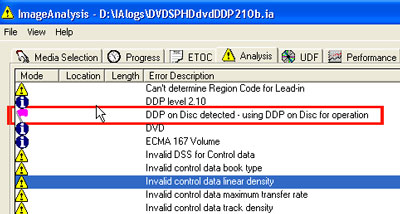
The above Eclipse ImageAnalysis report is for an HD DVD DDP file set on DVD-R output by DVD Studio Pro, so please disregard all the warnings. I used it just to show the 'DDP on Disc' indicator in ImageAnalysis readout :-)
Eclipse Data Technologies moved to help plants correct these expensive mishaps - (check out this thread: [DVDList] Replicator stamped DDP files on 3,000 units. Ouch.) with version 3 of ImageAnalysis in April 2004, which would abort the mastering process to prevent this occurrence. ImageAnalysis was further updated to extract the DDP Image data properly from a DVD-R, so a true DVD-Video DVD-ROM could be manufactured from it, with ImageAnalysis 4.0, in April, 2005 (this is quite an operation because the DVD-R doesn't 'know' how much data has been recorded to it), but Eclipse Data Technologies still recommends DLT submission.
A lot more could be said about the dangers of submitting the client's project for replication on recordables (like for instance, if you allow Adobe Encore to write the DVD-R, it will stripe all the VOB's with 'DVD recordable identifiers', which will get on the final replicated disc!). It's best if the authoring studio 'ties themselves to the mast' if they want to hear the siren song of DVD-R master submission, before sailing on.
Accounting for the Authoring System
Complete DVD verification/Quality Control, of course, starts well before the formatting of the Image. Proper asset preparation and creation is crucial, and the particular authoring system employed; it's weaknesses and strengths must be known and accounted for. No authoring system is exempt from settings in the interface that can cause errors and/or trip up verifiers and analyzers.
The ongoing saga of DVD Studio Pro®
Apple Computer™ entered the DVD Production arena, with it's April 2000 purchase of the German DVD Authoring company, "Astarte". It became "DVD Studio Pro®" a year later. It's price point and feature set brought in large numbers of professionals into DVD production, however, it came on the market with a cumbersome "Abstraction Layer", and is to this day still stricken by seemingly inexplicable DVD Specification lapses ( even with the later 2002 acquisition of Spruce Technologies, and switching DVD Studio Pro to an entirely different code set!).

DVD Studio Pro's Transition feature cause multiple player laser seeks, instead of just one or two, which increases the time it takes to go from one menu to another, and can cause some players to choke.
Currently, DVD Studio Pro's "Abstraction Layer", i.e., it's behind the scenes auto-programming and asset domain placement routines, also allows possible combinations that result in DVD Specification violations, player incompatibilities, i.e. slow and/or erratic navigation and/or outright crashing the player. Please see; Problems with DVD Studio Pro's Abstraction Layer Solved.
But DVD Studio Pro allows some project types just not available this side of $10,000 and can be induced to output perfectly spec compliant streams with it's multiplexing. And according to extensive tests, DVD Studio Pro outputs much more spec compliant UDF file structures than Sonic Scenarist!
I've worked with DVD Studio Pro for over 7 years now, starting back when it was 'simultaneously' Astarte DVDirector and Spruce Maestro. For me, and others it's a known entity, being now completely predictable in both its mistakes, and being able to summon out of it what's needed. With a little help, it has the capability to output the most spec compliant and player compatible DVD's on the market.
However, to output trouble free and tolerably efficient navigation with DVD Studio Pro, requires knowledge of:
- The DVD-Video Specifications.
- What the Abstraction Layer is doing behind the scenes and how best to coax it to minimize it's extravagances.
- Avoiding its particular interface settings that have remained for years, which can throw the project out of spec, outright.
- And various other known procedural and feature avoidances that are offered and allowed in the program.
Btw, if you think DVD Studio Pro has issues, a lot of problems are being experienced with Adobe Encore DVD out there, too. No DVD Authoring system is exempt from the need to check it's output thoroughly.
Adjusting Authoring to be compatible with Players
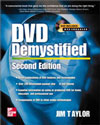 Jim Taylor, Chief DVD Technology Officer at Sonic Solutions™ on his DVD Demystified web site, points to there being a need to adjust authoring procedures to increase general player compatibility, as he explains why the replicated DVD included with his book has problems playing in dozens of DVD players: Jim Taylor, Chief DVD Technology Officer at Sonic Solutions™ on his DVD Demystified web site, points to there being a need to adjust authoring procedures to increase general player compatibility, as he explains why the replicated DVD included with his book has problems playing in dozens of DVD players:
"The DVD Demystified disc was carefully authored in full compliance of the DVD-Video specification with few considerations for player deficiencies. Therefore, it will reveal flaws in many DVD players. See the Gotcha! list below for details."
This example shows the prudence in expanding the idea of DVD Verification and Quality Control to include checks on the startup, layout and other authoring considerations that effect player compatibility of the final disc.
We will be taking up the issue of adjusting DVD authoring for specific and whole classes of players (i.e. cheap ones, certain brands, known troublesome players, etc.) at the DVD Producers' Guild, using DVD Demystified Second Edition DVD as one of the examples. This is a huge subject, that will fundamentally change the way authors normally think about going about their trade (multiple start up actions, multiple navigation programming techniques for the same and fallback routing, multiple duplicate same menu targets in different domains, etc), which are near central to an expanded DVD project proofing and verification effort. |
|
TFDVDEdit 2 & 3 
Trai Introduces TFDVDEdit 2, at
NAB, April 2003. The Program would later become known as "DVDAfterEdit", in 2005.


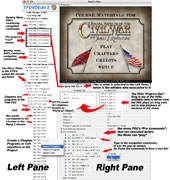
TFDVDEdit becomes one of the most powerful media utilities by impact, in any industry.


Trai Forrester's 'New Constellation Technologies' becomes licensed with the DVD Forum for PART III: VIDEO SPECIFICATIONS, as part of the TFDVDEdit development effort, in 2003

The old TFDVDEdit.com site:
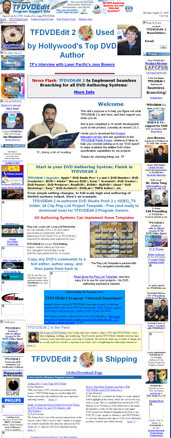
The TFDVDEdit support site becomes an exciting gathering point for Hollywood's top DVD Authors, all the way down to rank good DVD newbies, and every class of author in between.

The old TFDVDEdit 3 Mastering Edition web site: 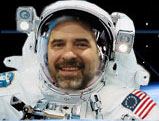
Trai was on 'stellar cloud NC457', with his own High-End DVD Pre-mastering system.
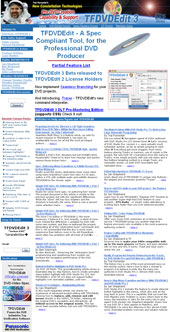

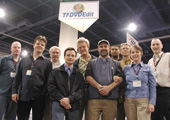
NAB 2004 TFDVDEdit 3 Mastering Edition Launch TFDVDEdit top beta testers fly in from around the US and the world for the whole week, to help man the booth. From left to right - Ben Weinrach, Ian Shepherd, Ernie Brock, Alex Alexzander, Larry Applegate, Trai Forrester, Jake Russell, Professor Uli Plank, Wendy Forrester and John Calderbank.

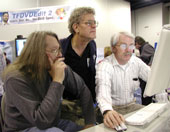
The TFDVDEdit Mastering Edition programming team, from left to right: Main programmer John Brisbin, Larry Applegate, and Ernie Brock helped with Tracer.
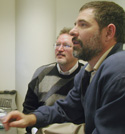
Trai demonstrates TFDVDEdit to Randy Hudson, CEO of Broadness, in their New York City Studios, fall 2003. Randy will later go on to use TFDVDEdit Mastering Edition to format hundreds of DVD Images for replication.

Some of Trai's Important Professional Collaborations:
Victor Tung
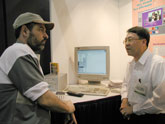
Ken Byrd introduces Trai to Victor Tung, of Authoringware at NAB April 2000. Victor is a gracious, walking DVD Spec encyclopedia.
Victor Tung & TFDVDEdit
Trai introduces his joint venture partner Larry Applegate to Victor Tung and his programming skills in October 2003. Victor's code becomes the basis for TFDVDEdit Mastering Edition ISO/UDF Bridge, for its Images.

Victor Tung is the programmer for all of DVD-lab PRO's DVD Specification libraries.

"Trai... The DVD Verification lab is a brilliant idea. I know a lot of people were looking for something like this to appear. Incidentally, you are probably the best person anybody could hope for to engage in that area.”
-Roman Voska, owner and principle of MediaChance and DVD-lab Pro.

John Brisbin

Trai meets John Brisbin on May 15th, 2001. Their collaboration changes the DVD Industry:
MPEG Append
By August, 2001, John Brisbin creates Mpeg Append. Trai had asked John for the needed utility and becomes the sole alpha/beta tester. On August 10th, 2001, John gives the go ahead for Trai to announce the program's release for further testing to the DVD Industry.
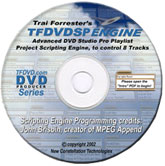
TFDVDSP Engine
John Brisbin and Trai collaborate on
the "TFDVDSP Engine", the first
professional DVD Studio Pro Advanced Play list Project Templates, by early 2002.
TFDVD-9 Maker
John Brisbin helps Trai with crucial calculations; first, to identify legal Layer Break locations in the VOB,
by hex character value with just
a glance! And nifty calculations to help users bit budget
their projects for TFDVD-9 Maker.
 TFDVDEdit TFDVDEdit
Trai introduces John Brisbin to his
joint venture partner Larry
Applegate in June, 2003. John Brisbin
becomes TFDVDEdit's lead programmer.

Professor Uli Plank


Uli Plank has written 3 acclaimed books (in German) on DVD Studio Pro with large sections on TFDVDEdit in the last two. Uli was TFDVD.com's biggest contributor, and close collaborator of Trai's since the Spring of 2001.

Trai's Webmaster, Bill Myers, comes up with a new name for TFDVDEdit - 'DVDAfterEdit'. It sounded so good that Trai agreed to the product's name change, Summer, 2005

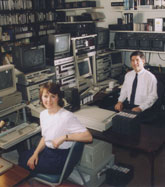
Trai and his wife of 20 years, Wendy in their Studio back in Ft Worth, Texas, in 1993.
Trai owned Classic Video Productions for almost 10 years. He's used to working creatively, on deadlines, for high-end clients.
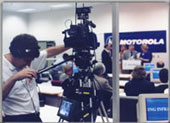

"You may be the 'Socrates of DVD', but it's my Bandwidth!"
Quote from a DVD List post referring to Trai, by John Blakney, host of the Tully professional DVD List, in June of 2003

"Trai is the 'judge, jury, and executioner' of the DVD Industry"
Lou Skriba, 30 year Media Industry veteran, known as the "Godfather of DVD".

"Mr DVD"

Barry Greenburg, of Digital Video Design dubs Trai "Mr.DVD", in 1999. Barry was Trai's first Astarte DVDirector system package customer (see below), who still has the napkin which was the receipt dated in 1999 for items ordered (given as he was handing Trai a $15,000 check! They both laugh about the 'cutting edge transaction' to this day).

Almost two years before Apple purchased Astarte, Trai had seen the DVDirector program's value, and starting in 1999, with the creation of his company 'New Constellation Technologies', quickly became the number 1 Astarte dealer in the world; helping bring scores of companies into DVD Production for the first time. During this period, Trai worked closely with Freddie Gieir, Mike Evangelist and Adrian Ramsier, all then of Astarte.


Apple hired Trai as a private consultant to help Introduce DVD Studio Pro in 2001; due to his several years experience with Astarte DVDirector; DVD SP's predecessor. Trai shown working the Apple booth at NAB April, 2001. Photo credit - Lou Skriba

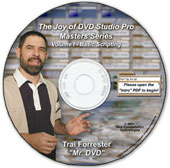
Trai releases the Industry's first comprehensive DVD Scripting Tutorials in July of 2001, and in it warned of the need to adjust DVD authoring strategies for player compatibility with his famous article entitled; "On the most perfect start-up action".
"Trai's Scripting Disc taught me how to 'think DVD'."
Marc McCoy

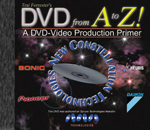
Trai can be seen on Jim Taylor's DVD Demystified Second Edition DVD, advertising his work still in progress; "DVD from A to Z"
. 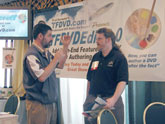
Trai assures Jim Taylor at the DVD Association Convention in June of 2003, that his TFDVDEdit program works well with Scenarist®.


Trai sells his 50% interest in the DVDAfterEdit joint venture in November, 2005.

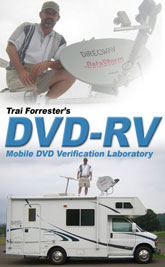
Trai goes on a 16,500 mile coast to coast and back odyssey; to promote
DVD Verification and a new Professional DVD Producers' Guild, as part of his launch of TFDVD Research
Labs. Trai meets with authors, replicators, tool makers, and others. DVD projects are verified in a record 14 different cities, in a span 5 months.

TFDVD Research Labs officially launched in
September, 2005, with the concept of the "Certified DVD Image" - an Industry First.


Trai's 5 year dream to create a Union for professional DVD Authors is coming to fruition over at the former TFDVD.com site. |